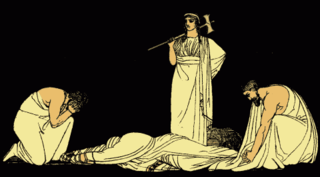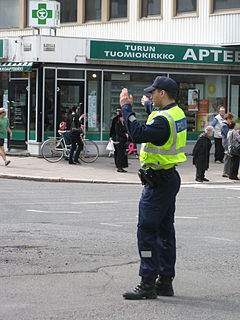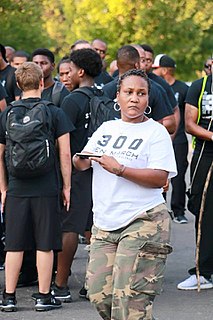Citizens Against Homicide (CAH) is a non-profit, public benefits organization based in California. The group supports the friends and relatives of homicide victims by honoring the deceased, advocating for families seeking criminal justice for the murders, and supporting crime legislation that keeps the citizenry safe. CAH was cofounded in 1994 by Jane Alexander, whose thirteen-year search for the murderer of her 88-year-old aunt inspired the book Citizen Jane , and Jan Miller, whose 19-year-old daughter Veronica was murdered in an unsolved 1984 case. [1] By 1998, the group had become active in all 50 U.S. states and had a mailing list into the thousands. [2] The group's membership actively assists the prosecution of murderers by writing letters to block the parole of convicted murderers and providing advice to families about the criminal justice system.

Murder is the unlawful killing of another human without justification or valid excuse, especially the unlawful killing of another human with malice aforethought. This state of mind may, depending upon the jurisdiction, distinguish murder from other forms of unlawful homicide, such as manslaughter. Manslaughter is killing committed in the absence of malice, brought about by reasonable provocation, or diminished capacity. Involuntary manslaughter, where it is recognized, is a killing that lacks all but the most attenuated guilty intent, recklessness.

Homicide is an act of a human killing another person. A homicide requires only a volitional act that causes the death of another, and thus a homicide may result from accidental, reckless, or negligent acts even if there is no intent to cause harm. Homicides can be divided into many overlapping legal categories, including murder, manslaughter, justifiable homicide, killing in war, euthanasia, and capital punishment, depending on the circumstances of the death. These different types of homicides are often treated very differently in human societies; some are considered crimes, while others are permitted or even ordered by the legal system.
A violent crime, violent felony, crime of violence or crime of a violent nature is a crime in which an offender or perpetrator uses or threatens to use harmful force upon a victim. This entails both crimes in which the violent act is the objective, such as murder, assault, rape and assassination, as well as crimes in which violence is used as a method of coercion or show of force, such as robbery, extortion and terrorism. Violent crimes may, or may not, be committed with weapons. Depending on the jurisdiction, violent crimes may regarded with varying severities from homicide to harassment.
Victim Support is an independent charity in England and Wales that provides specialist practical and emotional support to victims and witnesses of crime.
Crime in Australia is managed by various law enforcement bodies, the federal and state-based criminal justice systems and state-based correctional services.
The rate of crime in Japan ranges as generally low to moderate in comparison to other countries, depending on most cities and towns. Issues still remain, and many crimes manifest in several forms; especially in regards to organized crimes and massacres. In 2015, Japan had one of the lowest murder rates in the world, but higher than Singapore.
Nuestras Hijas de Regreso a Casa A.C. is a non-profit organization composed of mothers, family members, and friends of victims of the female homicides in Ciudad Juárez. The mothers claim that their cases have gone unsolved in some cases for over 12 years. Their hope is to get the murderers of their daughters arrested and hopefully convicted.

Capital punishment in Japan is a legal penalty. It is applied in practice only for aggravated murder, although it is also permitted for certain crimes against the state, such as treason. Executions are carried out by hanging.

Crime is one of the most urgent concerns facing Mexico, as Mexican drug trafficking rings play a major role in the flow of cocaine, methamphetamine, fentanyl, heroin, and marijuana transiting between Latin America and the United States. Drug trafficking has led to corruption, which has had a deleterious effect on Mexico's Federal Representative Republic. Drug trafficking and organized crime have been a major source of violent crime in Mexico. Drug cartels and gangs have also branched out to conduct alternative illegal activities for profit, including sex trafficking in Mexico. Some of the most increasingly violent states in Mexico in 2020 included Guanajuato, Zacatecas, Michoacán, Jalisco, and Querétaro. Some of the world's most violent cities are reportedly within the state of Guanajuato with extortion from criminal groups now being commonplace. The state of Zacatecas is said to be valuable to multiple organized crime groups for drug trafficking, specifically methamphetamine to the United States. As of 2021, Michoacán is experiencing increased instances of extortion and kidnapping due to a growing presence and escalation in the armed conflicts between CJNG and Cárteles Unidos on regions bordering the neighboring state of Jalisco. CJNG is also currently battling the Los Chapitos faction of the Sinaloa Cartel in the North Mexican region of Sonora.

Crime in the United States has been recorded since the early 1600s. Crime rates have varied over time, with a sharp rise after 1900 and reaching a broad bulging peak between the 1970s and early 1990s. After 1994, crime rates began to fall year by year. This trend lasted until 2015, where crime rates began to rise slightly. This reversed in 2018 and 2019, but violent crime increased significantly again in 2020. Despite the increase in crime between 2020 and 2021, the quantity of overall crime is still far below the peak of crime seen in the United States during the late 1980s and early 1990s.
Crime in Toronto has been relatively low in comparison to other major cities, but recently, it saw a record number of shootings in 2019. In 2017, a ranking of 60 cities by The Economist ranked Toronto as the 24th safest major city in the world, behind Tokyo, London, Paris, and Seoul, but one of the safest major cities in North America. A CEOWORLD magazine ranked Toronto as the 95th safest city in the world for 2018, running behind several other major cities like Tokyo, London, Osaka, Singapore, Hong Kong, and Taipei but safer than most cities in North America.
The smiley face murder theory is a theory advanced by retired New York City detectives Kevin Gannon and Anthony Duarte, and Dr. Lee Gilbertson, a criminal justice professor and gang expert at St. Cloud State University. It alleges that a number of young men found dead in bodies of water across several Midwestern American states from the late 1990s to the 2010s did not accidentally drown, as concluded by law enforcement agencies, but were victims of a serial killer or killers.

Citizen Jane is a 1999 true crime non-fiction book by James Dalessandro about the real-life efforts of a woman to track down the con artist who murdered her aunt.
This article refers to crime in the American state of California.
Rates of crime in Guatemala are very high. An average of 101 murders per week were reported in 2018. The countries with the highest crime and violence rates in Central America are El Salvador and Honduras. In the 1990s Guatemala had four cities feature in Latin America's top ten cities by murder rate: Escuintla, Izabal (127), Santa Rosa Cuilapa (111) and Guatemala City (101). According to New Yorker magazine, in 2009, "fewer civilians were reported killed in the war zone of Iraq than were shot, stabbed, or beaten to death in Guatemala," and 97% of homicides "remain unsolved." Much of the violent nature of Guatemalan society stems back to a 36-year-long civil war However, not only has violence maintained its presence in the post-war context of the country following the Guatemalan Civil War, but it has extended to broader social and economic forms of violence.
Crime in Oakland, California, began to rise during the late 1960s, and by the end of the 1970s Oakland's per capita murder rate had risen to twice that of San Francisco or New York City. In 1983, the National Journal referred to Oakland as the "1983 crime capital" of the San Francisco Bay Area. Crime continued to escalate during the 1980s and 1990s, and during the first decade of the 21st century Oakland has consistently been listed as one of the most dangerous large cities in the United States.
Crime in Venezuela is widespread, with violent crimes such as murder and kidnapping increasing annually. In 2014, the United Nations attributed crime to the poor political and economic environment in the country—which, at the time, had the second highest murder rate in the world. Rates of crime rapidly began to increase during the presidency of Hugo Chávez due to the institutional instability of his Bolivarian government, underfunding of police resources, and severe inequality. Chávez's government sought a cultural hegemony by promoting class conflict and social fragmentation, which in turn encouraged "criminal gangs to kill, kidnap, rob and extort". Upon Chávez's death in 2013, Venezuela was ranked the most insecure nation in the world by Gallup.

Marcia Lenore Sossoman (King) was a 21-year-old Arkansas woman who was murdered in April 1981 and whose body was discovered in Troy, Ohio approximately 48 hours after her murder. Her body remained unidentified for 36 years before being identified via DNA analysis and genetic genealogy in April 2018. King was one of the first unidentified decedents to be identified via this method of forensic investigation.

Crime in Finland is combated by the Finnish police and other agencies.

Erricka Bridgeford is an African American activist from Baltimore. She worked to get Maryland's death penalty law repealed in 2013, and founded and co-organizes quarterly 72-hour "Ceasefire" weekends. Baltimore Ceasefire weekends began in 2017, in the hope of reducing violence. Erricka was named 2017's Marylander of the Year by The Baltimore Sun.